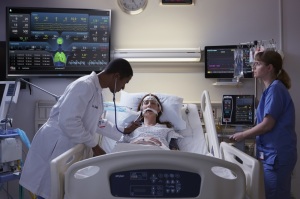by
John R. Fischer, Senior Reporter | April 06, 2018
Clinicians overburdened with monitoring data from various medical devices can evaluate info in real-time on a single screen with Masimo’s UniView.
The integrated display derives and organizes data from a variety of sources, ranging from patient monitors to anesthesia gas machines, allowing multiple clinicians in ORs and ICUs to view information on one or more large central monitors to better coordinate care and improve patient safety.
“When treating or diagnosing a patient, clinicians rely on data from multiple medical devices, in conjunction with their judgment and other factors,” Bilal Muhsin, EVP for engineering, marketing, and regulatory affairs, told HCB News. “With UniView, clinicians can view data trended over time from multiple devices on a single screen. Having a single display may help teams coordinate care.”



Ad Statistics
Times Displayed: 73960
Times Visited: 2466 Ampronix, a Top Master Distributor for Sony Medical, provides Sales, Service & Exchanges for Sony Surgical Displays, Printers, & More. Rely on Us for Expert Support Tailored to Your Needs. Email info@ampronix.com or Call 949-273-8000 for Premier Pricing.
The number of displays and user interfaces can often overwhelm clinicians who are unable to view data from various medical devices in use, leading to clinician burnout and suboptimal patient care from the siloing of information.
UniView organizes and provides supplementary displays of information collected from multiple Masimo and third-party devices, enabling clinicians to simultaneously view and act in response to the same, comprehensive, real-time patient status and historical trends.
Data is organized based on the types and number of devices connected. Fewer devices enable UniView to resize the display area to accommodate available data, including parameters, trends and waveforms.
The solution provides visual alarm indicators and related parameter data from connected devices to indicate patient distress, eliminating the need to search for the source of the alarm and enabling clinicians to target areas that require immediate attention.
It also is equipped with tailored, use-case-specific screen layouts to optimize how advanced and integrated parameters, trend data and waveforms for diverse clinical scenarios are shown. These include its Overview layout for viewing monitoring data from all connected point-of-care and therapeutic devices to assess patient status; its Hemodynamics layout for assessing data for noninvasive hemoglobin, pleth variability and pulse rate to visualize patient status over time; its Oxygenation layout for ventilator waveform viewing, as well as noninvasive trended hemoglobin and oxygen status; and its Sedation layout to picture high-fidelity EEG waveforms, patient state index and anesthesia machine data for patient sedation monitoring.

